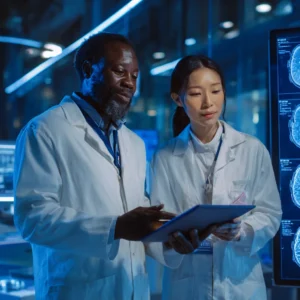What Are Some Potential Uses of Induced Pluripotent Stem Cells & how do they actually work? Imagine taking regular adult cells and turning them into super-cells that can transform into nearly any type of cell in the body—that’s what scientists do with induced pluripotent stem cells (iPSCs). They reprogram skin cells or blood cells to behave like stem cells, unlocking huge potential for medical treatments and research.
(Remember, if you’re thinking about getting Stem Cell Therapy, fill out our form here. Our Team will help you decide if it’s really for you, differences between treatment in different countries and work on getting you some discounts!)
How Are Adult Cells Used to Create iPSCs?
It’s like hitting the rewind button on adult cells! Scientists take skin or blood cells, reprogram them using advanced genetic techniques, and suddenly they become as versatile as stem cells. The result? They can now morph into any cell type, opening doors for personalized treatments without the ethical concerns of embryonic stem cells. Think of it as turning back the biological clock!
To read more about the different types of Stem Cells, check the article we put together here.
How Are Induced Pluripotent Stem Cells Different From MSC Cells?
Here’s where iPSCs take the crown. Mesenchymal stem cells (MSCs), often taken from umbilical cords, bone marrow or fat, can only turn into a limited number of cell types—think bone, cartilage, and muscle. But iPSCs? They can transform into virtually any cell type in the body, making them the star player for regenerative medicine.
How Are They Different From Embryonic Stem Cells?
Both iPSCs and embryonic stem cells (ESCs) can become any cell type, but here’s the big difference: iPSCs come from adult cells, like skin or blood, so they dodge the ethical debates surrounding embryo use. This makes iPSCs a more socially accepted option while still offering the same flexibility as ESCs.
What Are the Risks of Using iPSCs?
With great power comes great responsibility—and some risks. iPSCs are incredibly versatile, but their rapid division can sometimes lead to tumor formation, like teratomas. Reprogramming cells can also cause genetic mutations, which might increase the risk of cancer. Plus, iPSCs might carry some of the memory from their original adult cell state, making them less effective in certain therapies. You can read more of the research here.
Long-term safety is still a bit of a mystery, as most studies haven’t followed patients for extended periods yet.
How Can Induced Pluripotent Stem Cells Be Used in Stem Cell Therapy?
The promise of personalized medicine is where iPSCs really shine. Since they’re made from a patient’s own cells, they lower the risk of rejection. Scientists are already exploring their use in regenerating damaged tissues for conditions like heart disease, Parkinson’s disease, and even vision loss. It’s like having a tailor-made treatment that fits perfectly.
Examples of Recent Studies using IPSC Cells in 2025?
Fertilo iPSC-Based Therapy (Gameto): 2025
Participants: Not yet disclosed
Current Phase: Phase 3 (FDA IND cleared)
Details: Gameto’s Fertilo is the first induced pluripotent stem cell (iPSC)-based therapy to enter a Phase 3 clinical trial in the U.S. Fertilo is a treatment designed to help women going through IVF by improving how eggs mature outside the body. It uses lab-grown support cells (made from iPSCs) to help eggs develop better, which could boost IVF success rates and reduce the need for high-dose hormone treatments
Results so far:
Successful preclinical studies – Early trials suggest that lab-grown ovarian support cells (made from iPSCs) can help eggs mature more effectively, which could improve IVF success rates
FDA IND Clearance – The U.S. FDA approved Fertilo to proceed to a Phase 3 trial, marking a major step for iPSC-based reproductive therapies.
Potential to reduce hormone use – If successful, Fertilo could lower the reliance on high-dose hormone injections, making IVF safer and more accessible.
Why it Matters
- First iPSC therapy in a Phase 3 trial → This is the most advanced iPSC-based reproductive therapy to date.
- Could revolutionize fertility treatments → By improving egg maturation outside the body, Fertilo may increase IVF success rates, particularly for women with low ovarian reserves.
- Next steps: Gameto will conduct its Phase 3 trial to evaluate safety, efficacy, and real-world clinical outcomes before potential FDA approval.
The full press release is here.
2025 Pluripotent Stem Cell Review
A review done in 2025 (it’s here if you want to read it yourself) mentioned:
- There are now 59 iPSC-based clinical trials worldwide.
- Japan’s leading the way in iPSC research
Most of the studies are based around treating:
- Neurological Disorders: iPSC-derived neurons are being tested for Parkinson’s disease and ALS (amyotrophic lateral sclerosis).
- Cardiovascular Diseases: iPSC-derived cardiomyocytes (heart cells) are being studied for treating heart failure and other cardiac conditions.
- Ophthalmic Disorders: Researchers are using iPSC-derived retinal cells to treat age-related macular degeneration (AMD).
- Metabolic Conditions: iPSC-derived pancreatic beta cells are being trialed for Type 1 diabetes, aiming to restore insulin production.
Pre 2025 Stem Cell Trials using IPSC Cells
iPS Cell Therapy for Spinal Cord Injury in Japan
(For more details, you can read the press release)
Who’s Running This Study?
Researchers at Keio University in Tokyo, led by Professors Hideyuki Okano and Masaya Nakamura, are conducting a pioneering clinical trial. They’re exploring the use of induced pluripotent stem cells to treat patients with spinal cord injuries.
Who Took Part?
- 4 adult male patients who had suffered complete spinal cord injuries (classified as Grade A on the ASIA Impairment Scale).
- Injuries were located between the C3/4 and T10 vertebrae.
- Patients were treated during the subacute phase, meaning 14 to 28 days post-injury.
How Did It Work?
- Each patient received an injection of approximately 2 million neural stem/progenitor cells, derived from iPS cells, directly into the site of their spinal cord injury.
- These iPS cells were originally created by reprogramming adult cells back into a stem-cell-like state, allowing them to develop into various types of cells, including neural cells.
- The primary goal was to assess the safety of this treatment; evaluating its effectiveness was a secondary objective.
Results So Far
- Safety: No serious adverse events were reported in any of the four patients over a one-year follow-up period.
- Motor Function Improvements: Two out of the four patients experienced notable improvements:
– One patient regained the ability to stand unaided and has begun practicing walking.
– Both patients can now eat independently, a significant milestone for individuals who had lost movement below the neck or chest. - The other two patients did not show significant functional improvements, highlighting variability in responses.
What This Means
- This study represents a promising step forward in treating spinal cord injuries using regenerative medicine.
- While the sample size is small, the improvements observed in two patients suggest that iPS cell-derived neural stem cell transplantation could potentially restore some motor functions in individuals with severe spinal cord injuries.
- Further research with larger participant groups is necessary to confirm these findings and determine the treatment’s overall efficacy.
Next Steps
- The research team plans to expand their studies, focusing on:
– Increasing the number of transplanted neural stem cells.
– Testing the treatment on patients in the chronic phase of spinal cord injury (months or years post-injury), where nerve regeneration is typically more challenging/ - These steps aim to further assess the therapy’s safety and effectiveness, with the hope of making it a viable treatment option for a broader range of patients.
How Effective Are IPSC Stem Cell Treatments So Far?
- Some neurological and cardiac trials have shown promising results, but long-term efficacy is still unknown.
- Beta-cell trials for Type 1 diabetes have helped some patients reduce their insulin needs. But most still require some level of external insulin support.
- Eye-related therapies (retinal cell transplants) are among the most successful so far, with some restored vision, though not perfect eyesight.
Why Aren’t Induced Pluripotent Stem Cells Used in Mainstream Stem Cell Therapy?
Despite their massive potential, the risks of tumor formation and genetic instability during reprogramming are the main barriers.
Since iPSCs are artificially reprogrammed, there’s always a chance they don’t fully reset, leading to abnormal cell behavior or even tumor formation (teratomas).
Although research is moving quickly, we still need long-term studies to confirm their safety before they can become a standard therapy.
One recent study looked at over 100 different iPSC lines and found that not all of them behave the same way. Some were great at transforming into different cell types, while others struggled to function properly. This inconsistency is a big reason why iPSCs aren’t widely used in treatments yet. The research also refines our understanding of how iPSCs and ESCs function, you can go through it yourself here.
We provide you with unbiased information helping you learn about Stem Cell Therapy & see if it’s right for you. Our platform can also connect you with the best clinics in the right areas & get you some cool discounts! Fill out our form here to learn more. ( Our Find a clinic page is coming soon!)
iPSCs have the potential to revolutionize medicine by regenerating damaged tissues, treating diseases like diabetes and Parkinson’s, and creating patient-specific therapies. Researchers are testing IPSC cell for drug testing, reducing the need for animal studies. One day they could help grow lab made organs for transplants.
Embryonic stem cells (ESCs) are like the all-stars of the cell world! They come from early-stage embryos and can turn into any cell type in the body, making them super versatile. But here’s the catch: using ESCs can be controversial because harvesting them involves destroying the embryo, which raises ethical concerns. Plus, there’s a risk of these cells forming tumors since they can grow uncontrollably if not handled correctly. That’s why many people prefer Mesenchymal Stem Cells (MSCs) from adult tissues like bone marrow or umbilical cords. They view MSC therapies as less risky and free from ethical concerns
1) Regenerative Medicine: Stem cells can help repair damaged tissues. Making them useful for conditions like spinal cord injuries, heart disease, and joint degeneration.
2) Disease Treatment: Scientists are using stem cells to develop therapies for diabetes, Parkinson’s, and certain types of cancer by replacing or repairing affected cells.
3_ Drug Testing & Research: Stem cells allow researchers to study diseases and test new treatments in lab-grown human cells. Reducing the need for animal testing.
Fill in your details below
For a discounted offer for Stem Cell Therapy!






